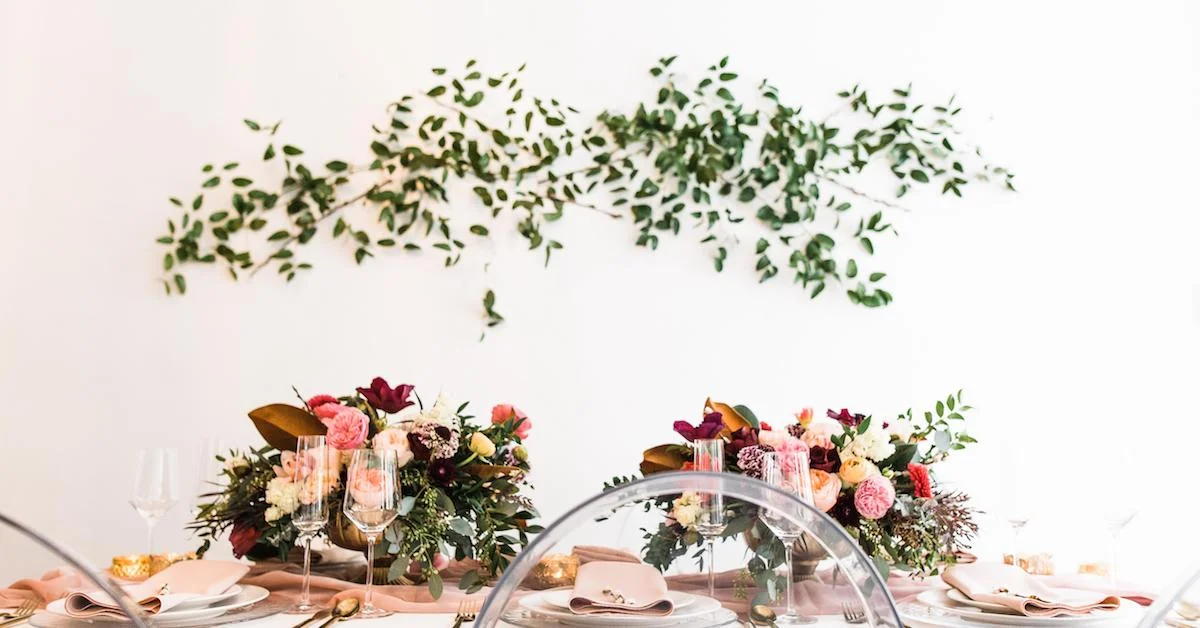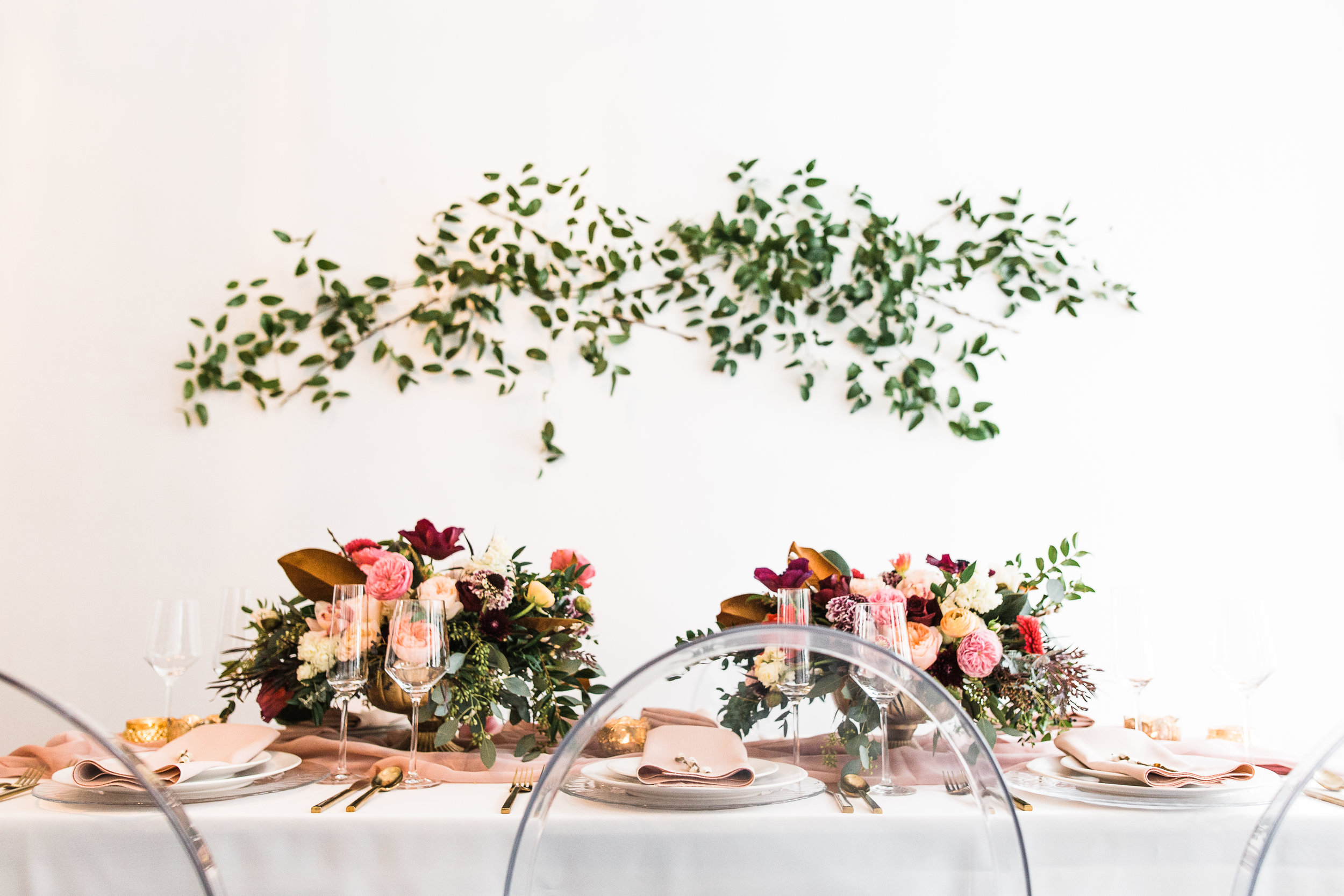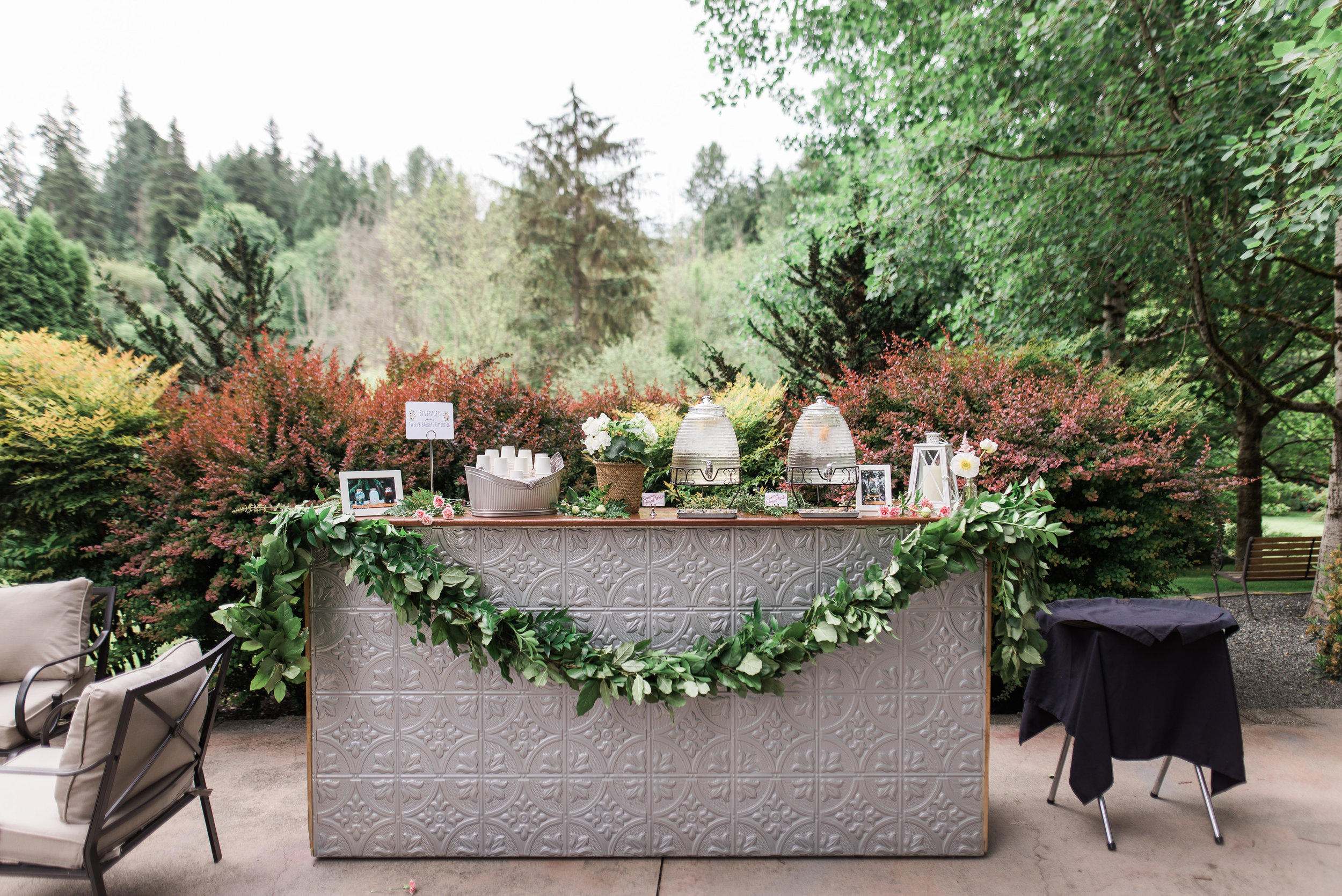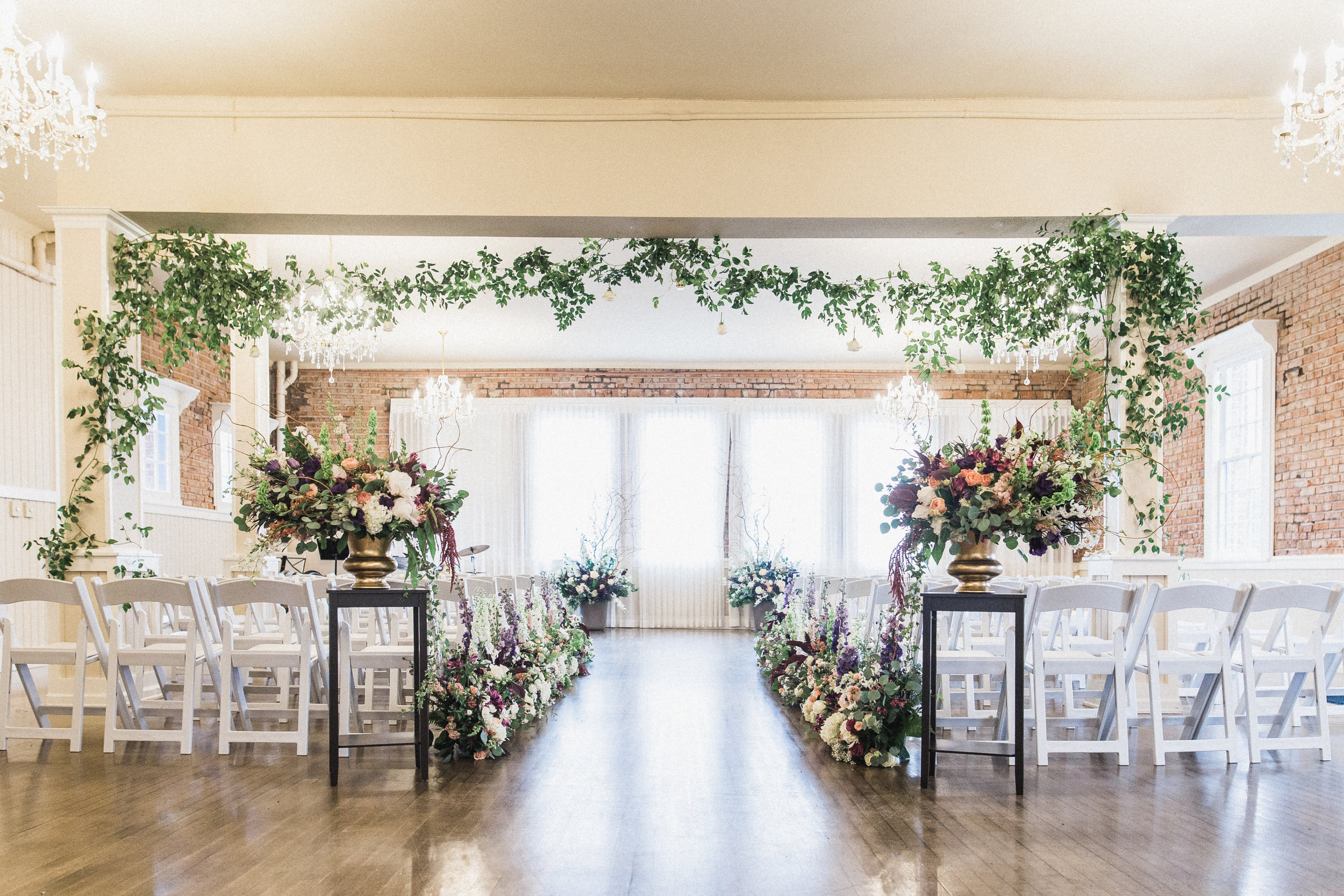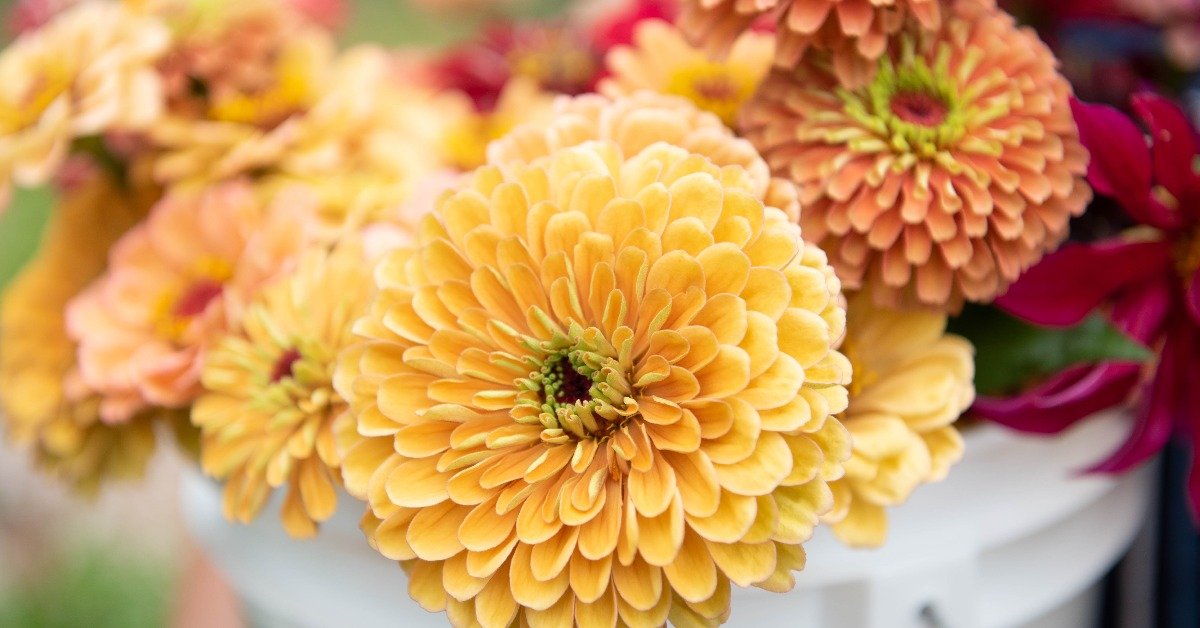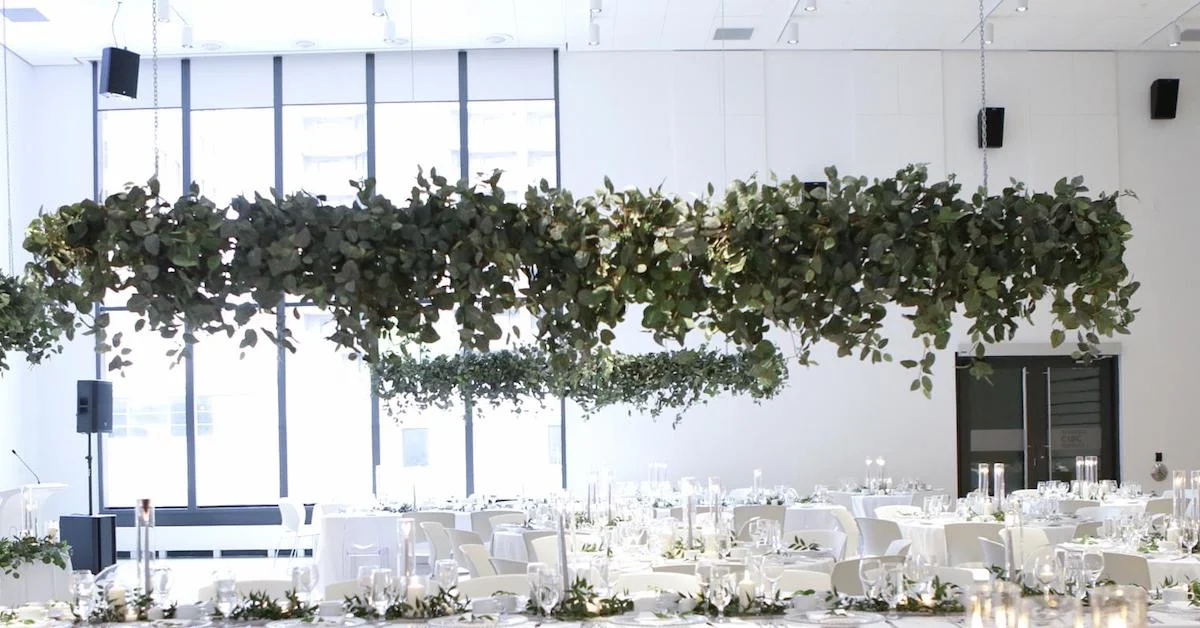Hanging Vines and Greenery on Any Surface
Have you ever had a bride send over an image of hanging greenery sprawled on a wall and think “How on earth do I do that?”
As a floral designer, I love the challenge of creating and hanging these masterpieces for wedding decorations—hanging floral arrangements (made of greenery alone or peppered with florals) are gorgeous and effective mood-setters. But it can be difficult to know how to hang vines on a wall or install ceiling vines. Every surface requires something different!
I’m here to show you my tips, tricks, and toolkit for building some unforgettable greenery displays on a variety of surfaces.
Julia Kinnunen Photography
Method of hanging: fishing line and chicken wire armature
If you’re stuck wondering how to hang greenery vines on a wall, from the ceiling, and more, this article will give you insight! We’ll cover these important points for hanging greenery from any surface:
Start with the venue. What anchor points are available? Are there any restrictions? Will you be hanging greenery from brick, concrete, drywall, or the ceiling?
Decide on the greenery with your client. For a grey-green option, consider eucalyptus or olive foliage.
Prep your toolkit for the floral installation. See an extensive list of items below.
Hang greenery or vines from your chosen surface. Happy installing!
Continue reading for a full and complete guide!
Feel free to jump ahead to the section of this article that you need for today:
Important considerations when working with hanging floral arrangements
List of greenery that works well for hanging ceiling vines, vines on walls, and so much more!
The floral designer’s toolkit for hanging floral arrangements and vines
How to hang vines and greenery on wallpaper, painted walls, and windows
Attaching greenery to fabric, pipe and drape, and cocktail tables
How to Hang Greenery: Start with the Venue and Your Materials
When a client first shows me their greenery inspirations or hanging floral arrangements, I try to envision the mechanics. How can I make this work?
I need to take into consideration the venue and its rules or restrictions for wedding decorations and hanging greenery or florals, so I like to do a site visit with my client to uncover any possible issues beforehand.
When I visit the venue, I make sure to do two things:
Locate attachment points.
Discuss the plan and scope of the job with the venue.
Conducting in-person research has saved me a few times in the past when venues won’t allow wedding décor on particular areas or object to certain hanging methods. And getting approval prior to the event is a great way to build vendor connections and demonstrate respect for their space.
Hi! We’re Team Flower.
We help flower pros and fans from every part of the floral world learn, grow, and connect through industry-leading education. Learn more about how we can help on your flower journey here.
Tawni Eakman Photography
Method of hanging: Gaffers Tape
Greenery that Works Well for Hanging
Greenery used in floral installations needs to be hardy and withstand conditions without a water source.
There are times when I will water tube or use Oasis foam, but often the materials are without water for long periods of time. Hardy waxy greenery works well in these types of conditions.
Below is a list of greenery I’ve found works well for hanging floral arrangements or ceiling vines across ar room.
Southern Smilax
Italian Ruscus
Nagi
Salal
Magnolia
Huckleberry
Camelia Foliage
Eucalyptus (silver dollar, seeded, spiral)
Olive Foliage
What’s Inside My Greenery Hanging Toolkit
My greenery hanging toolkit is extensive. I like to have multiple ways to hang and attach vines or greenery to a wall because I never know what challenge might present itself.
All the items in my toolkit are available on Amazon and in most home improvement stores like Home Depot or Lowes.
Saltwater Fishing Line (Have few different varieties of fishing line available. The weight used will vary depending on what you’re hanging. I like to have some 15–20 lb., 60 lb. and 150 lb. on hand.)
Gaffers Tape – ½” and 1” in white and black
Uglu Dashes (Oasis Brand)
Spring Clamps
C Clamps
Brick Clips
4” Black Zip Ties
Chicken Wire (a small roll of it, to create a quick armature if needed)
Suction Cups with Hook
Safety Pins
Command Hooks
Hot Glue Gun
When approaching a job, the wall surface dictates the types of mechanics that are used. Here’s a breakdown of what I have found to work for each surface.
How to Attach Greenery, Vines, and Foliage on a Variety of Surfaces
Okay, here we go. In this next section, I’ll dive into what I do to secure materials on a variety of surfaces. All methods use items from my toolkit mentioned above. Feel free to scroll on through to find the specific surface you’re working to attach greenery to.
Alante Photography
Method of hanging: hot glue and brick clips
Hanging Greenery Vines on Brick Walls
Brick clips are an excellent tool for hanging floral arrangements, like larger foliage pieces and florals on a brick wall. They also provide an anchor point to suspend Oasis cages or attach greenery.
In addition, fishing line can be strung between clips to create a vine-like look on the wall.
Greenery can be wrapped or strategically zip tied on the line (the 4” black zip ties blend in nicely).
Hot glue can also work on a traditional brick wall if you only need to attach a few pieces of greenery or a single rose. I found white polo roses worked well and didn’t show any heat damage.
The hot glue gun needs to be on high heat and the glue very hot to work, and it will peel right off the brick post-event. (I have only used this method on traditional red brick and recommend testing it out if trying on a painted brick surface first.)
How to Hang Vines and Greenery on Wallpaper, Painted Walls, and Windows
I love using gaffers tape to hang greenery on walls as it doesn’t leave a residue or damage paint or wallpaper. Gaffers tape is not very strong, so it’s only appropriate for attaching simple greens to a wall. I prefer to use a thin ½” size.
I cross two strips of tape in an X fashion on the piece of foliage and will typically do this one to two times for each piece depending on weight. To hide the tape, I will take a round leaf (salal and silver dollar eucalyptus work well), loop a piece of gaffer tape on the back, and then place the leaf over the visible tape.
To hang greenery on windows or glass frames, a suction cup hook is the key. They are easy to hide behind curtains and can hold a surprising amount of weight. Even floral wreaths can be hung in windows with a large suction cup.
Rachel Birkhofer Photography
Method of hanging: Gaffers tape
Securing Vines on Concrete or Wood Walls
For concrete or wood walls, I have found that Uglu dashes, gaffers tape, and Command hooks work well and don’t cause any damage.
I rarely use Command hooks because I’ve had them pull off paint/wallpaper in the past, but on hard, durable surfaces like wood or concrete they work well and are easily removable.
Tessa Tadlock Photography
Method of hanging: fishing line
Greenery on Fabric, Pipe and Drape, and Cocktail Tables
Safety pins can be used to help hold foliage on fabric, and fishing line can be run between two pins to create a structure to weave greenery through.
Straight pins (boutonniere pins) can also be used to help attach lightweight greenery to fabric surfaces.
If you’re asked to do a tie of greenery on a cocktail table, I like to use bind wire to gather up the tablecloth, and then I wrap greenery pieces onto the bind wire. Make sure your client orders linens that are long enough to be gathered without showing the table legs.
Attaching Vines and Greenery to Columns or Poles
To secure greenery on columns or poles, fishing line can be wrapped down the column/pole and the greenery woven into the fishing line.
Gaffers tape can also help to secure individual pieces of the fishing line.
Dressing Up Ledges, Bars, and Tables
B. Jones Photography
Method of hanging: 4" spring clamp
To affix a greenery garland to the front of a table, bar, or fireplace mantle, I like to use either C-clamps or spring clamps. My toolbox has both available in varying sizes (mine go from 2” to 6”).
Simply clamp the device onto the ledge or surface you want to cover, and then zip-tie the garland onto the clamp. The clamp is easily covered with greens or a few roses depending on the look you want to achieve.
Check out our Advanced Wiring Techniques online floral design class and discover how to extend the potential of blooms beyond their natural boundaries in your floral designs.
Garnishing String or Cafe Lights with Greenery
I like using Italian ruscus for greenery vines on string lights because it’s easy to attach—and easy to determine how many stems are needed. Italian ruscus is about 2–3 feet long, so I will take the length of string lights being used and divide by 2. This gives me the number of stems needed and will build in a little room for extra length if some pieces are shorter than others.
The night before the event, I’ll prep the Italian ruscus by zip tying two pieces together at their stems to create longer pieces about 5 feet in length, which I then store in a flower box in my cooler. These pieces can then easily be wrapped onto the string lights, often without needing any extra attaching, although occasionally I might use a small 4” zip tie if they’re loose.
Urbanlight Studios
Method of hanging- Brick clips, chicken wire and fishing line for the wall piece, Italian ruscus for the string lights wrapped
Foliage on Ceilings or Ceiling Vines for Long Passes Across a Room
Fishing line is fantastic for bringing greenery across a room or stringing ceiling vines overhead. Just be sure to use a line that has a weight limit which can handle the amount of items hung on the line.
I’m a worrier/over-planner, so I will typically use a 150 lb-tested fishing line for greens crossing over people’s heads. Southern Smilax is my favorite greenery to use for this type of installation as it quickly expands to fill large spaces. A couple of pieces can cover a large area.
GH Kim Photography
Method of Hanging: fishing line
Rachel Birkhofer Photography, Drawing: The Fancy Cat Studio
Method of Hanging: Gaffers Tape
Final Tips for Hanging Vines and Greenery
When all other methods for hanging fail, look up and to the sides of where you are working. I always have fishing line in my toolbox because it can be used to create a hanging point from almost anywhere you can tie it.
Maybe there’s a small nail that you can run a line to or a ledge that a clamp can be secured to with fishing line hung from it? Over the years, I’ve had to get really creative, and having a wide variety of tools to choose from has helped me be successful.
Of all the recent wedding decoration trends in floral design, hanging greenery on walls, ledges, windows, doorways, and ceilings is one of my favorites.
Greenery can transform a room, and I love enhancing the guests’ experience with these beautiful displays. Hopefully, this article gave you some ideas for your installations. If you ever need help figuring out mechanics, feel free to send me a message or email, as I love helping with this sort of thing. Happy hanging!

